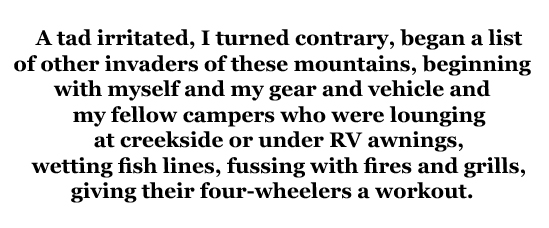A July day in Horse Canyon, northern Nevada. Cheatgrass was abundant, especially along the cattle trail. Barbed “florets” snagged my sneakers and socks and worked into the fabrics and stabbed. Dozens of them, and they were hard to dislodge. Lacking forceps I went after the worst ones with my teeth. Humiliating, time-consuming. I tried walking barefoot, but the trail was too rocky. There were no alternate routes, the narrow canyon bottoms being literally choked by a noisy stream and its tall jungle. Finally, I simply held a steady pace, accepting pain.
Cheatgrass, Bromus tectorum, invaded from Europe in the 1880s and found ideal conditions on roadsides and other exposed places. It competes with native plants, but does not necessarily displace them. It can be beautiful in early summer, pale green and silky in shimmering masses. Grazing animals can use it then, before it dries and polishes its armament.
The canyon broadened and branched, cheatgrass dwindled, having met the fringes of a new set of conditions: alpine-like meadows. I stopped at the creek bank and worked on shoes and socks. The sun was low. Decision time. Should I run the gauntlet again? I drank from the canteen. Not much left. Afraid of Giardia, I didn’t take water from the creek.
I decided to try for the spine of the range and follow that down and out. It was hard traveling, heaving upward through aromatic brush. The ridges ahead began to reveal their complexities. Too much unknown territory up there, and I’d be moving in thirst and darkness. Not wise.
I retreated, took the cheatgrass way, settled into a steady grind. Pain, some bloodshed. I made it to the car and poked it along a two-track road. Erosion ruts, sounds of sifting dust and ghostly dry brush scraping by, and then the highway embankment loaded with shimmers of pinkish-brown Bromus tectorum, ripe and ready. Not long after that encounter I holed up in a Bureau of Land Management campground in Wyoming. I brewed coffee and read a glossy little BLM pamphlet called Noxious Weeds. A Growing Concern. Ten of the aliens were identified.
Spotted Knapweed, Leafy Spurge, and so on. They are bad because they “displace native plant species that provide habitat for wildlife and food for people and livestock.” One of them is poisonous. The pamphlet tells us that we can all help with invasions by not transporting unknown flowers, by not giving our horses feed that might contain noxious seeds, and by driving only on “established roads and trails.” Cheatgrass wasn’t mentioned. Next day was a good one. I followed elk and deer and wild horse trails and logging roads to a fine view of Whiskey Peak. Back in camp I re-read Noxious Weeds. Some of the swatches of yellow color in meadows and old clearcuts had looked suspiciously like one of the aliens, Dalmatian Toadflax. If so, I wanted to know if it is really serious, or moderately so, and what are the realistic chances of defeating it. Will it exterminate Paintbrush, Geranium, Phlox, Wild Buckwheat and the other good, solid Americans? Or might they all arrive at some sort of coexistence and in the process add a bit more color and variety to the ecosystem. But wouldn’t the answers to these questions vary, depending on each terrain’s degree of erosion and grazing, its fire regime, floral composition, soil structure, weather pattern? The pamphlet had only a color photo of Dalmatian Toadflax and five words of description, “…extensive and deep root system.” It’s noxious, never mind the details, take our word for it. That was the message.
A tad irritated, I turned contrary, began a list of other invaders of these mountains, beginning with myself and my gear and vehicle and my fellow campers who were lounging at creekside or under RV awnings, wetting fish lines, fussing with fires and grills, giving their four-wheelers a workout.I recalled the wealth of information that turned up in my previous cheatgrass research. Fascinating stuff. Soil and climate and altitude preferences; growth habit; season of danger to grazers; fire hazard; experiments in progress to determine where it might be a threat, and where possibly not.
Come on, BLM, trust us, give us more data and the big picture. We might take an interest. With what you’re giving us so far you can’t really believe we’ll go all bushy-tailed to make ourselves activists in the war against aliens. We’ve got enough troubles. Oh, we might refrain from picking and transporting beautiful strangers, but I don’t see many of us making sure that “within 96 hours before entering back country (we) give pack animals only food that is certified weed free.”
Come to think of it, I wonder if the battles against noxious aliens are already being lost because of reckless building of logging and mining and oil/gas roads into back country, under your supervision. You can’t blame us for wondering why you and the Forest Service don’t get together and wipe out a few thousand miles of old roads and two-tracks whose total mileage now exceeds that of the entire interstate system.
Never mind, I’m out of here. What’s this? A little brown envelope into which I forgot to enclose the camping fee. Damn, this is really irritating. If you feds need more money, and I’m sure you do, and I’m all for it, go get it from taxes and you know which brackets to hit. This is our land, you know; this is public land. Okay? Oh well, thanks for not charging me a trailhead fee.
(Cheatgrass is a shortened version of a piece first published in the Anderson Valley Advertiser, Aug. 11, 1999).
MARTIN MURIE died in January 2012. His words live on here in The Zephyr.
To read the PDF version of this article, click here.
Don’t forget the Zephyr ads! All links are hot!






